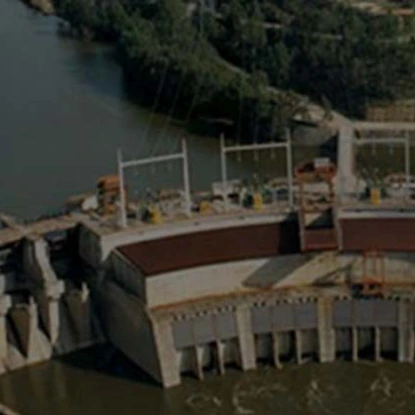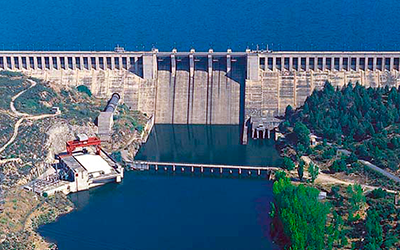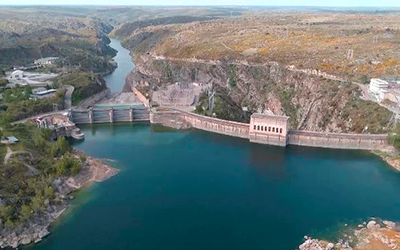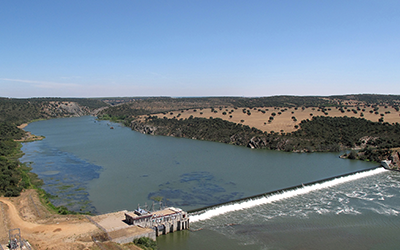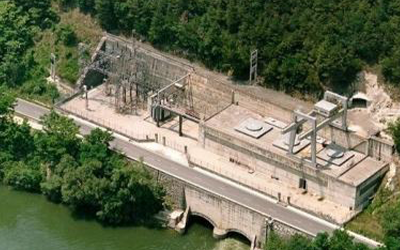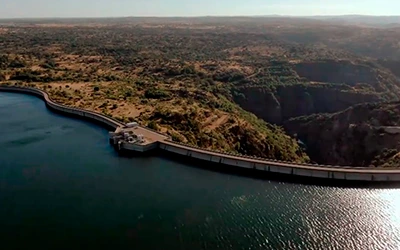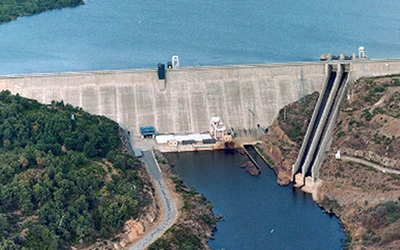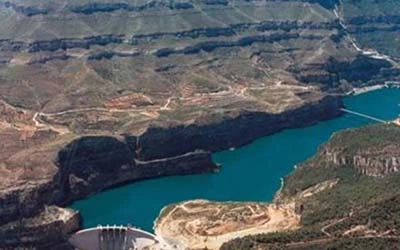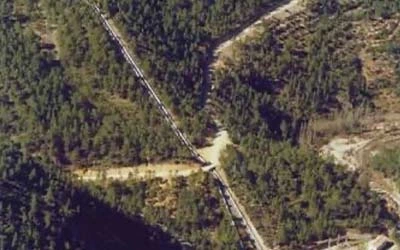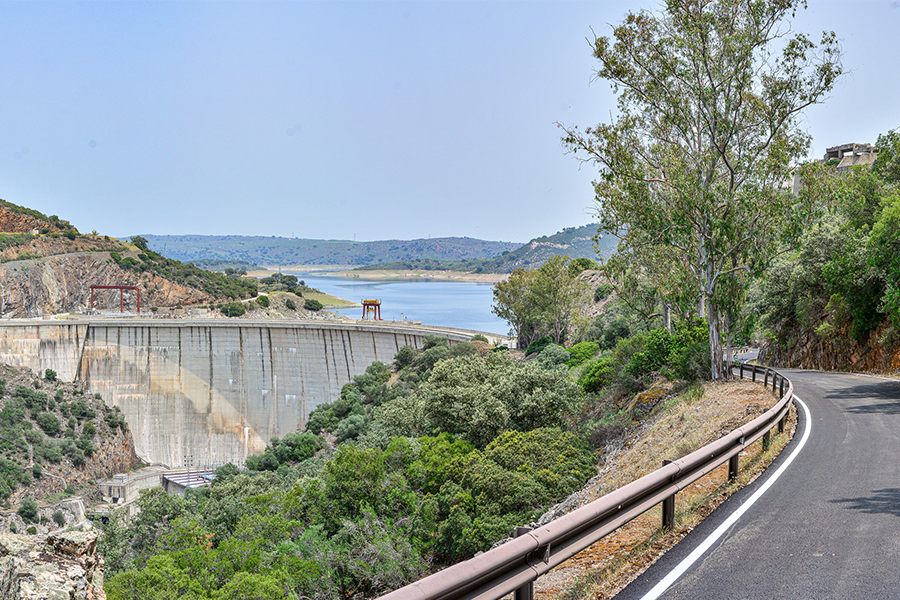TAGUS RIVER BASIN: OUR HYDROELECTRIC POWER STATIONS
Alcántara and Cedillo, two fundamental sources of hydroelectric energy in the passage of the Tagus through Extremadura
Iberdrola España has a presence in five hydroelectric plants and three mini-hydroelectric plants in the basin of the Tagus River, the longest river on the Iberian Peninsula, as it flows through Castilla-La Mancha and Extremadura. More than 2,000 MW of installed capacity with the capacity to offer clean and sustainable energy to more than 1.4 million families, with the José María de Oriol plant in Cáceres, on the Alcántara reservoir, and the Cedillo plant, on the Cedillo reservoir, standing out for their high production.
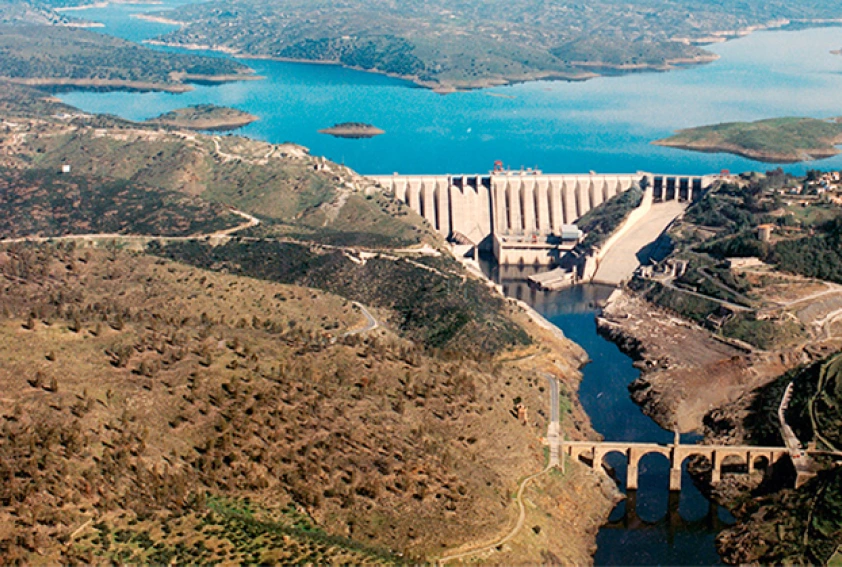
HYDROELECTRIC PLANTS IN THE TORMES BASIN




The Tagus is the longest river on the Iberian Peninsula, more than 1,000 kilometres long, rising in the Montes Universales in Teruel and flowing into the Atlantic Ocean at Lisbon. It flows through the central part of Spain from east to west, with a slight inclination towards the south, which is accentuated when it reaches Portugal, after crossing the regions of Aragon, Castile-La Mancha, Madrid and Extremadura. The Tagus basin has a total surface area of 80,600 km² (57,000 km² in Spanish territory) and its good management is of vital importance as it has the largest population in the Iberian Peninsula, with more than ten million inhabitants, as it includes the metropolitan area of Madrid and the Lisbon region.
The Tagus basin has considerable hydroelectric potential, due to its geographical extension and the presence of several rivers and tributaries that feed reservoirs and allow the generation of hydroelectric energy. The use of its waters in the Spanish section, which is 836 kilometres long, is regulated by the Confederación Hidrográfica del Tajo (CH Tajo). The Tagus is managed from the river's passage through Talavera de la Reina, in Toledo, to the Portuguese border.
In order to do this, over the years we have developed five power plants and three mini-hydroelectric plants in the provinces of Toledo and Cáceres, including the José María de Oriol plant in Alcántara (Cáceres), which is key to renewable energy production in Extremadura. Thanks to this set of hydroelectric infrastructures in the Tagus basin as it flows through Spain, we can generate approximately 1,920 MW of renewable, clean and cheap energy. A quantity of green electricity that benefits more than 1,300,000 households in Spain.
Tagus reservoir
The Tagus basin reaches a total reservoir capacity of more than 11,000 hm³ of water in Spanish territory, according to data from the CH Tajo. In this basin, we can find large-capacity reservoirs that act as important regulators of water flow, as elements for flood control and drought mitigation and as hydroelectric power generators.
Iberdrola España is active in five reservoirs in the Tagus basin. Following the downstream direction of the river: Azután, Valdecañas, Torrejón-Tajo, Alcántara and Cedillo.
Azután Reservoir
The Azután reservoir is located in Alcolea de Tajo, in Toledo, and is the dam on the Tagus closest to Talavera de la Reina, the point at which Iberdrola España began to have a presence in this hydrographic basin. Completed in 1969, Azután has a capacity of 113 cubic hectometres (hm³) of water and a surface area of 1,250 hectares (ha). The reservoir has a dam with single buttresses, each 12 metres wide, with a maximum height from the foundations of 55 metres and an extensive crest length of 411 metres.
Valdecañas reservoir
The Valdecañas reservoir occupies land in the municipalities of Valdecañas de Tajo and Belvis de Monroy, in the province of Cáceres. It was commissioned in 1964 and has a total capacity of 1,446 hm³ and a surface area of 7,300 ha. The reservoir provides a supply and risk service to the local population and is an open space for hiking, which in addition to housing and caring for a multitude of species, takes advantage of the energy potential thanks to the Valdecañas dam, a 98-metre-high double-curvature vault dam.
Torrejón-Tajo reservoir
The Torrejón-Tajo reservoir is located in the municipalities of Toril and Torrejón el Rubio, in Cáceres, in the privileged setting of the Monfragüe National Park. The reservoir, with a capacity of 188 hm³ and a surface area of 1,041 ha, was inaugurated in 1966 and provides water supply and irrigation services for the local population. The concrete dam built on the Torrejón-Tajo reservoir, of the curved gravity type, has a maximum height of 62 metres from the foundations and a crest length of 300 metres.
Alcántara reservoir
The Alcántara reservoir, located in the municipality of the same name, in Cáceres, was completed and put into operation in 1969. With a total capacity of 3,160 hm³, a length of 91 kilometres and a surface area of 10,400 hectares, it was the largest reservoir built in Spain until 1990. The reservoir supplies the local population and is used for recreational activities, such as boating and catering or picnics on the shore.
Alcántara also has the José María de Oriol dam, an imposing lightened gravity dam with a double buttress, 130 metres high and a crest of 570 metres. This dam brings together the confluent waters of the Tagus, the Alagón and the Tiétar (the latter two being tributaries of the former).
Cedillo reservoir
The Cedillo reservoir is located in the Cáceres municipality of Cedillo, on the international stretch of the Tagus River between Spain and Portugal, and is the last Spanish dam on the Tagus before it enters Portugal. Completed in 1978, it has a capacity of 260 hm³ of water and a surface area of 1,400 ha, and is used for hydroelectric power generation, navigation and fishing.
Cedillo has a unique arch-gravity dam, built at the confluence of the Tagus and Sever rivers, with a height of 66 metres and a crest length of almost 413 metres. Curiously, the abutments of the dam rest in Portuguese territory, and access to the central area is from Spanish territory via a 70-metre long bridge that crosses the reservoir.
(*) All the data provided on reservoir capacity and surface area come from the specialised website embalses.net.
Hydroelectric power stations of the Tagus river basin
The hydroelectric generation plants in the Tagus basin are distributed between the La Mancha province of Toledo, where the Azután plant is located (municipality of Alcolea del Tajo) and the Extremadura province of Cáceres, where the Valdecañas (municipality of Valdecañas de Tajo), Torrejón (Torrejón el Rubio), José María de Oriol (Alcántara) and Cedillo (Cedillo) plants are located. In addition, Palomarejo, La Milagrosa and Talavera (in Talavera de la Reina, Toledo) complete this powerful system of renewable energy plants in the Tagus basin, through smaller hydroelectric developments.
Iberdrola España's commitment to sustainability and the promotion of renewable energies is reflected in this commitment to hydroelectric generation on the Tagus. In addition to offering a clean and affordable source of electricity, the construction, management and maintenance of all these hydraulic infrastructures has a significant positive impact on the area: generating jobs locally, stimulating the economy, strengthening the infrastructure and promoting sustainable development in the communities of Castilla-La Mancha and, above all, Extremadura. All of this is subject to the different laws and controls required at any given time.
José María de Oriol
The José María de Oriol hydroelectric plant is popularly known as the Alcántara plant, due to its proximity to the municipality of the same name and the name of the reservoir where it is located on the course of the Tagus. This outdoor facility, commissioned in 1969, is one of the cornerstones of Iberdrola España's renewable energy production in Extremadura, with an installed capacity of 957 MW, more than any of the company's other facilities in the region and enough to supply electricity to more than 640,000 families.
Cedillo
In operation since 1975 on the Cedillo reservoir, the Cedillo hydroelectric power plant is an outdoor type at the foot of the dam and has a head of almost 50 metres. Its 499.78 MW of rated capacity generates renewable energy capable of benefiting some 308,000 households and makes it another milestone in the expansion of renewable potential in Extremadura.
In this same municipality in Cáceres, we installed the Cedillo complex of photovoltaic plants in 2022, developing a complex logistical solution to jointly distribute the energy produced by these solar plants and the Cedillo hydroelectric plant, guaranteeing the minimum environmental impact in the surroundings of the Alto Tajo Natural Park, a protected area between Spain and Portugal.
Valdecañas
At the foot of the Valdecañas reservoir is the Valdecañas outdoor hydroelectric power station, which was commissioned in 1964, has a waterfall of 75 metres and an installed capacity of 249,20 MW, renewable energy for almost 160,000 homes. What's more, the facility has a battery system with a storage capacity of 15MW, which can be charged at times when there is excess production and supply energy at peak demand times of the day, thus allowing the management of energy surpluses.
Azután
The Azután hydroelectric power station, on the reservoir of the same name, was commissioned in 1969 with a gross head of just over 32 metres. It is an external dam with an installed capacity of 200 MW, which is equivalent to renewable electricity for some 126,000 Spanish households.
Torrejón
The Torrejón hydroelectric power station is located in the municipality of Toril, in Cáceres, and uses water from two reservoirs: the Torrejón-Tajo, which transports water to the power station through an open-air canal; and the Torrejon-Tiétar (a river tributary of the Tagus), which transports water through a tunnel-type canal. It was commissioned in 1966 and is an outside well power station, with a waterfall of almost 50 metres and an installed capacity of 132,34 MW.
Torrejón currently offers three ways of hydroelectric use. One, as a generator through turbination, either by moving the water between the Torrejón-Tajo and José María Oriol reservoirs, or between Torrejón-Tiétar and Alcántara. And finally, as a generator through pumping between the Torrejón-Tiétar and Torrejón-Tajo reservoirs.
La Milagrosa and Talavera
Talavera-La Milagrosa, a gravity dam with a height of more than 12 metres, located on the Tagus River passing through the town of Talavera de la Reina in Toledo, has two mini-hydroelectric power stations on the outside. La Milagrosa, commissioned in 1958 with a head of 3.5 metres and an installed capacity of 0.71 MW, and Talavera, in operation since 2003, with a head of more than 5 metres and an installed capacity of 3.20 MW.
Palomarejo
The Palomarejo Dam is an external spillway-type weir located next to the mini hydroelectric power plant of the same name in Talavera de la Reina, Toledo, with a total length of 330 metres at the crest and a height from foundations of 5.44 metres. The Palomarejo plant, inaugurated in 2002, has a waterfall of 3.3 metres and an installed capacity of 2.1 MW.

